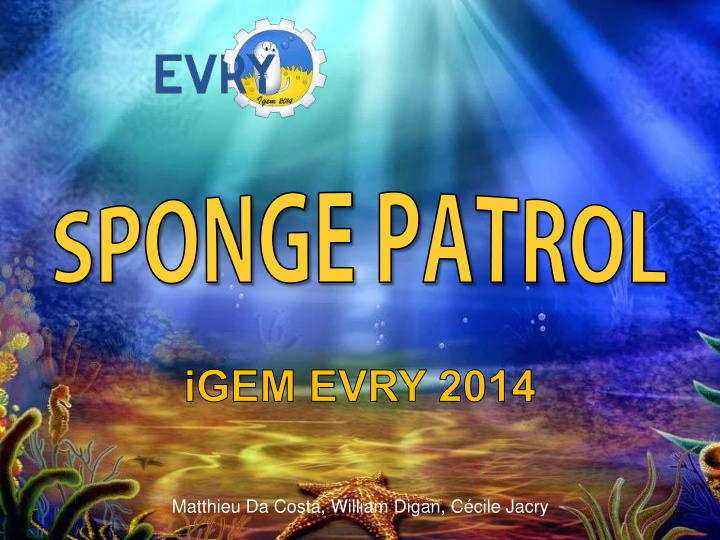



Matthieu Da Costa, William Digan, Cécile Jacry
Introduction This sphere represents all the water on Earth Its diameter is about 860 miles Wide range of toxic compounds
Introduction PCB Cadmium Lead Nitrite Phenol
Introduction PCB Cadmium Lead Spongia officinalis Nitrite Phenol
Introduction Combine the sponge filtration capacity and its microbiome to detect toxic compounds Filtrates Epibiosis 20 000 L of water/day/kg Are you allowed to modify my DNA ? Spongia officinalis Pseudovibrio denitrificans
Introduction Pseudovibrio is the main genus present in sponge microbiome Pseudovibrio denitrificans naturally has a denitrifying metabolism Filtrates Epibiosis 20 000 L of water/day/kg Oh ok ! Not me ! Spongia officinalis Pseudovibrio denitrificans
Policy and practices Should our sponge be considered as a GMO ? ≠ GMO GMMO Is modifying my microbiome any different than modifying my DNA ? Spongia officinalis Pseudovibrio denitrificans
Policy and practices Epibiosis: a biological containment? • Lack of competitivity • Strict Epibiosis • Physical containment Is it contagious ? Much better !
Policy and practices K lumsy L ame U gly D umb but G ood E nough Engineering biology Unexpected results Are you going to kludge me ?
Policy and practices Our goal : Engineering approach • Genome assembly of P.denitrificans Are you going to kludge me ? • Transcriptomic analysis • Sponge physiology model
Virtual Sponge Concentration of compound in contact with the sponge microbiome Oscula (out) Ostia (in) Main problems : • Complexity of sponge shape • Variability of sponge characteristics (number of ostia, oscula) • Bacteria location
Virtual Sponge Model 1 : fluxes Model 2: 2D Diffusion Geometry Result Compound accumulation caused by geometry
Genome Assembly 2006 2008 iGEM Evry team Enticknap JJ Muscholl-Silberhorn A 2010 2004 2007 2014 Santos OC Shieh WY Sertan-de Guzman AA Timeline of articles mentioning Pseudovibrio denitrificans Genome sequencing • Not very well documented Genome assembly • First transformation No transformation protocol • No genome assembly
Genome Assembly Annotation transfer Predicted pathway • Nitrate/ Nitrite reduction • Cadmium resistance • Phenol degradation • Exogen DNA digestion • Antibiotic resistance (Amp&Tet)
Genome Assembly A B C Antibiotic Effect Resistant Ampicilin resistant AMP (200ug.mL-1) Tetracyclin resistant Chloramphenicol sensible Kanamycin sensible A B Sensible D C CAM (33ug.mL-1) Growth on MB after 72 hours at 30 ° C with different A: P.denitrificans antibiotics B: Double selection C: E.coli D: Transformed E.coli
Biology According to the Genome Assembly : Electroporation + Electroporation + Transposon EcoKI Chemical Replicating plasmid
Biology • Tn10 = transposase • IS10 = repeat inverse • RFC10 compatible BBa_K1413044 plasmid map
Biology MW 1 2 3 4 NT 800 PCR products of kanamycin resistance gene 1, 2, 3 and 4 : clones of P. denitrificans transformed NT : No transformed P. denitrificans
Biology Cadmium No working BioBricks RNA Sequencing Lead Nitrite PCB Existing BioBricks Phenol (BBa_K1031211) (BBa_K1031222)
Biology SfGFP GFP + DmpR + ATP DmpR BBa K1413001 BBa K1413002 with GFP’s RBS BBa_B0032 with mutated GFP’s RBS According to Shine Dalgarno motif
Biology Fluorescence INTENSITY PER CELL Fluorescence INDUCTION RATIO vs BBa_K1413002 vs Bba_K1413002 16000 50 Fluorescence intensity per cell 14000 45 40 12000 Induction Ratio 35 10000 30 8000 25 6000 20 15 4000 10 2000 5 0 0 1h 6h 11h 1h 6h 11h 1h 6h 11h 1h 6h 11h BBa_k1413002 (mutated GFP’s RBS): Better strength Better sensitivity
Phenol Model Phenol ATP DmpR DmpR dimer No phenol degradation Phenol degradation
Interlab Study Corrected GFP fluorescence intensity Corrected GFP Fluorescence according to OD 600 nm at OD 600 nm = 0.45 • Characterized required promoters (I020260, J23101 and K823012 ) • 8 characterized out of 18 promoters tested in the Anderson Library
Achievements • Pseudovibrio denitrificans : • First marine bacteria in iGEM • First transformation • Genome sequencing/assembly BioBricks Submission Medal • Kludge BBa_K1413001 Received, Accepted • Virtual sponge model BBa_K1413002 Received, Accepted • 6 BioBricks submitted BBa_K1413021 Received, Accepted • 2 Improvements ( ) • BBa_K1413041 Received, Accepted 6 news BBa_K1413043 Received, Accepted • Compounds : • PCB and phenol biosensors BBa_K1413044 Received, Accepted • Phenol Model • Safety • Interlab study: 8 promoters characterized
Acknowledgement • Lab facilities: Institute of Systems & Synthetic Biology ( iSSB , Evry) • DNA /RNAs sequencing facilities: CEA (Genoscope, Evry) • Sponge microbiome advices: MDCEM team of the French National Museum of Natural History ( MNHN , Paris) • Conjugation plasmid: Institute of Molecular Enzyme Technology, Group of Bacterial Photobiotechnology ( Heinrich-Heine-Universität , Düsseldorf) • Sponge expertise: Mediterannean Institute of Biodiversity and Ecology ( IMBE , Marseille)
Acknowledgement • 4 advisors • 9 biologists • 2 supervisors • 3 bioinformaticians • 1 philosopher
Recommend
More recommend